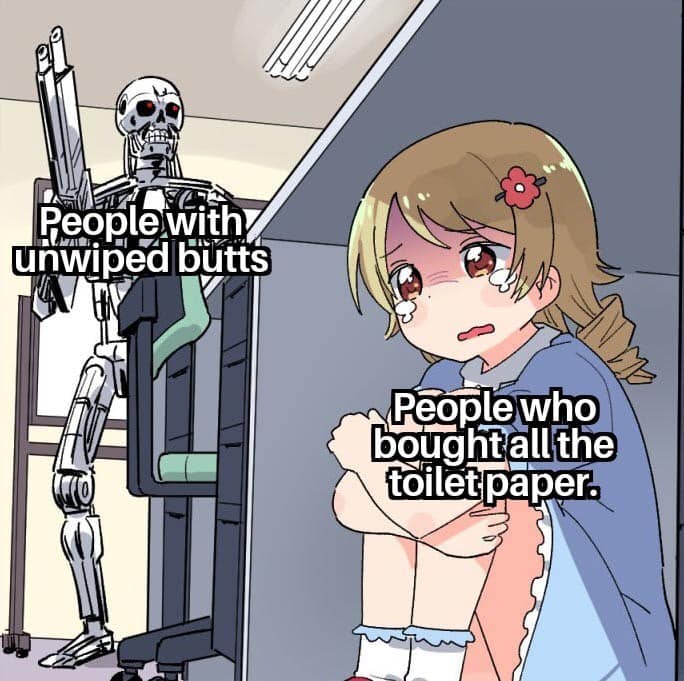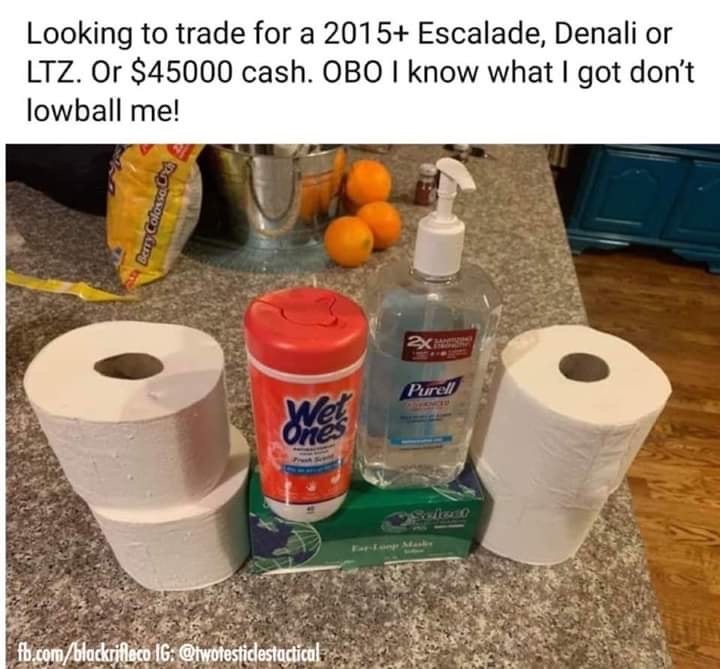
COVID-19 continues to swath of devastation. Events are closing in a cascading slide of destruction. People are beginning to panic.
But you aren’t! You’re more rational than that. And everyone you talk with is too, they’re keeping a level head… right?
Until that last square of TP comes off the roll…
How could this happen?!?
Easy, it’s the economics of panic. Or perhaps more accurately, the economics of scarcity. This doesn’t require burning stuff in the streets, mad-maxian convoys, or things we might flippantly call signs of a “real” panic. It only requires mild concern.
See, here is what happens (is happening). In SUPER basic not to scale terms. And why, if you haven’t stocked up, you probably should when you see the opportunity because the pool has already been disturbed mightily. Will disturbing it more exacerbate the issue? Probably, but you need TP.
Here’s the math, the oversimplified math but it essentially this is why wiping your butt has become a luxury. Bidet sales looking hot right now on Amazon.
You have 10 people who have heard about the COVID-19. Those 10 people consume 10 toilet paper rolls per X amount of time. TP is a stand in for necessary consumable, but it tends to be the most visible.
So… 10 for 10, right? And the local supply-mart stocks 12 just for a little redundancy. So they have more than enough… except that local supply-mart only restocks to 12. They don’t have the space to stock above 12, they don’t have the resources to draw from to supply above 12. Resource-mart’s supply chain is set specifically up for 12 and they regularly supply 10.
Well, enter COVID-19. Those 10 people who pull their sustainment resources (TP) from resource-mart all agree that, it’s no time to panic but it is worth ‘keeping an eye on’. 5 of the 10 decide that it wouldn’t be a bad idea to stock up just a little extra, nothing crazy, but just a little extra on stuff from resource-mart just in case. They buy two TP’s this time period instead of one, it’s not like they won’t use it after all.
Uh-oh…

10 people are drawing from a resource pool of 12 packs that stays at 12 for the normal consumption time period. But now those same 10 people want 15. Resource-mart is only set up to sustain 12.
So, the 5 people who decided to buy ‘just in case’ but they aren’t really worried all go shopping first. They’re a little more prepared and thinking ahead. Those 5 people take 10 out of the 12 resource. Resource-mart orders more because they need more. Meanwhile, while the new stock is enroute, the other 5 come in for their TP to resource-mart… but only 2 are able to get their normal amount and the other 3 or SOL.
Those 3 who are SOL are like, “Wow! There really is a panic run on TP.” The other 2 were surprised the stock was so low and vow to get a little more when they can. You know… just in case.
Stock comes in, 10 rolls to replace the 10 and an order is out for 2 more. The 3 who didn’t get any when they went shopping last time buy 2-3 each (Call it 8) and the 2 people who each got 1 of the last TP rolls each grab another. Resource-mart’s shelf is bare again.
The 10 people who normally by from a resource pool of 12 are now drawing it at a rate of 20+ and every time they go back into resource-mart they see that TP now “always” out of stock (based on their incredibly limited overall time spent in resource-mart, but cumulative observations).
Now we have resource scarcity. When any of those 10 see the resource (TP) now, they’re going to be more compelled to buy and buy extra. Resource-mart is reordering TP constantly and starting to strain their shipping and suppliers which begin to cost more money to keep deliveries on the way. Resource-mart can still only handle a stock of 12, and the resource-mart warehouse only holds 144 and supplies 11 resource-marts.
Demand has gone from ~10 to 20 on all of them and resource-mart warehouse now can only supply the resource-mart’s as they get supplied. They stock 144 but demand is now at 220+, all while the visible front of the store is saying TP is gone and has been gone more than once when someone checked.
TP is one of those resource types that we unconsciously think will always be there when we want it. We don’t consider its supply and storage space as finite or that it will ever be out-of-stock. We just don’t consciously believe this is possible, so when we discover that it is, it adds just a little bit more fuel to the panic fires.
Now, this is happening across international supply chains on multiple supply product lines and prices have gone up to compensate for the extra time and effort, and even dwell time (time without product that still needs to be paid for), involved in all these supply chains.

Simultaneously we’re restricting traffic flow and large highly infectious meeting locations in order to get ahead of the COVID-19 infection curve.
Make no mistake COVID-19 is only a special virus that it’s a slightly angrier flu. It has a higher and longer infection rate but it doesn’t actually hit someone much harder than the flu does. But that means a few more days off work or school and that many more people will be sick and have to take those days. Just like the resource-mart supply the ‘working hours’ supply of where we expect to spend our time is a fairly delicate balance.
This throws every single supply and business chain off its normal flow. Maxing and overstressing certain ones and cold stopping others. From a health perspective we’re making a wise series of choices to physically hamper the spread of COVID-19/Corona. From an resource perspective this is a huge drain to stop certain streams and keep others open.
Basically, we’re all in time out.
But, in good news

Keep a wary eye on what you need and buy it. Honestly, I hope you were one of my theoretical 5 and bought early.



